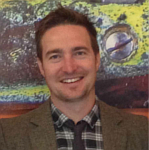
Richard Johnston
SSI fellow
I’m a senior lecturer in materials science within the College of Engineering at Swansea University, currently exploring the hidden micro world using X-rays. I can be contacted on Twitter.
Interests
X-ray microtomography, materials science, engineering, bioinspiration, biomimicry, structures in nature, aerospace, artificial intelligence, science communication and public engagement.
Research
I see inside things using X-rays. I lead a group that uses advanced materials science and engineering techniques to work collaboratively with diverse researchers. We image internal structures non-destructively at the microscale using X-ray microtomography; interpreting morphology and function from the 3D data. I work with a wide variety of materials and specimens, from mummified animals to jet engine components. Through X-ray microtomography we investigate the engineered and natural world – revealing structures that have never been seen before in 3D.
Our research is intimately intertwined with software. It is essential for running our equipment, reconstructing, visualizing, and analysing the large 3D datasets we generate. Current projects I lead/co-investigate include abradable coating materials in Rolls-Royce gas turbines, volcanic ash deposition, imaging the human remains from the Mary Rose, bioinspired structures from nature and 3D printing, additive layer manufacturing, medical device optimization, and model organisms for bone, among others.
Our research data and outputs are large, complex, and visual. We need to consider the reader/user when analysing and representing the research. X-Ray microtomography is multidisciplinary, and requires sharing of data and software with researchers in disparate fields.
Visualisation software is the language we use to communicate our findings. Typically this can be communicating with people who don’t work in microtomography, but are collaborators. I recognize that it can be difficult for researchers in very different areas to fully understand 3D data, particularly if we present them with a 2D representation of a 3D tomogram of the inside of a mummified cat! I also recognise the part software can play within research in communicating our findings to the public.
I have a passion for engaging people with research, and devised the #ResearchAsArt project, have worked on an art/science collaboration using X-rays, and run the Welsh Government-funded outreach programme Materials: Live
Check out contributions by and mentions of Richard Johnston on www.software.ac.uk
